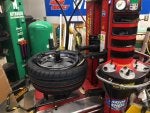According to this site, the stock tires that came on my car were 6.70-15, with running tire pressures (cold) of 24psi.
I have much wider tires on my car (225-55-17 front) and (275-50-17 rear) and I'm currently running a little over 30psi.
I beginning to think I am way overinflated.
I am looking for a softer ride but I still want to get good gas mileage and a good wear pattern.
Is there a way to figure out using the vehicle weight, and the load ranges of the wider tires at different psi settings, what I should be running?
Would appreciate any ideas people have, about how much pressure people think might give me the above results?
I have much wider tires on my car (225-55-17 front) and (275-50-17 rear) and I'm currently running a little over 30psi.
I beginning to think I am way overinflated.
I am looking for a softer ride but I still want to get good gas mileage and a good wear pattern.
Is there a way to figure out using the vehicle weight, and the load ranges of the wider tires at different psi settings, what I should be running?
Would appreciate any ideas people have, about how much pressure people think might give me the above results?





